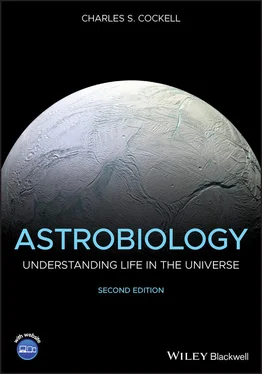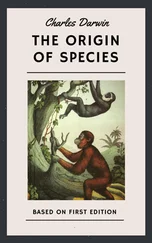21 18 The Astrobiology of Mars 18.1 Mars and Astrobiology 18.2 Martian Geological History: A Very Brief Summary 18.3 The Environmental Deterioration of Mars 18.4 Missions to Mars 18.5 Mars and Life 18.6 Trajectories of Martian Habitability 18.7 The Viking Program and the Search for Life 18.8 Searching for Life by Investigating Gases 18.9 Martian Meteorites 18.10 Mars Analog Environments 18.11 Panspermia: The Transfer of Life between Planets? 18.12 Conclusions Bibliography
22 19 Ocean Worlds and Icy Moons 19.1 The Astrobiology of Moons 19.2 The Moons of Jupiter: Europa 19.3 The Moons of Jupiter: Ganymede and Callisto 19.4 The Moons of Jupiter: Io 19.5 The Moons of Saturn: Enceladus 19.6 The Moons of Saturn: Titan 19.7 Other Icy Worlds 19.8 Planetary Protection 19.9 Conclusions Bibliography
23 20 Exoplanets and the Search for Life 20.1 Exoplanets and Life 20.2 Detecting Exoplanets 20.3 Exoplanet Properties 20.4 Detecting Life 20.5 Surface Biosignatures 20.6 How Likely Are These Signatures? 20.7 Other Ways to Find Life 20.8 Missions to Detect Biosignatures 20.9 Conclusions Bibliography
24 21 The Search for Extraterrestrial Intelligence 21.1 The Search for Extraterrestrial Intelligence (SETI) 21.2 Methods in the Search for Extraterrestrial Intelligence 21.3 Communication with Extraterrestrial Intelligence (CETI) 21.4 The Drake Equation 21.5 The Fermi Paradox 21.6 Classifying Civilizations 21.7 Policy Implications 21.8 Conclusions Bibliography
25 22 Our Civilization 22.1 Astrobiology and Human Civilization 22.2 The Emergence of Human Society 22.3 Threats to a Civilization 22.4 Climate Change and the Challenge to Civilization 22.5 The Human Future Beyond Earth 22.6 Settling the Solar System 22.7 Avoiding Extinction or Collapse: A Multiplanet Species 22.8 Environmentalism and Space Exploration as a Single Goal? 22.9 Sociology: The Overview Effect 22.10 Will We Become Interstellar? 22.11 Conclusions Bibliography
26 AppendixA.1 The Astrobiology Periodic Table A.2 Units and Scales A.3 Temperature Scale Conversion A.4 Composition of the Sun A.5 Some of the Major Star Types, Temperatures, and Colors A.6 Three- and One-Letter Designations of Amino Acids A.7 Codon Table for the Genetic Code Associated with mRNA (also shown in Chapter 5; Figure 5.12) A.8 Planetary Data A.9 Geological Time Scale
27 Glossary
28 Index
29 End User License Agreement
1 Chapter 1Table 1.1 The content of the textbook.
2 Chapter 4Table 4.1 A range of possible solvents for life, their temperature ranges, heat...
3 Chapter 6Table 6.1 Some examples of chemoautotrophic redox reactions.
4 Chapter 7Table 7.1 Examples of microbial extremophiles (italics) and extremotolerant (bo...Table 7.2 Some examples of products (mainly enzymes) and processes involving ex...
5 Chapter 8Table 8.1 Some examples of genes that can be sequenced and used to build phylog...
6 Chapter 10Table 10.1 A selection of the chemical formulae for just 25 gas phase carbon mo...
7 Chapter 12Table 12.1 Some of the compounds generated in the Miller–Urey experiment by mix...Table 12.2 Some examples of carbon compounds identified in carbonaceous chondri...
8 Chapter 13Table 13.1 Typical isotope standards.Table 13.2 Some example methods used to study ancient life in the rock record....
9 Chapter 14Table 14.1 Some examples of common isotopes used to date rocks with their half-...
10 Chapter 16Table 16.1 The five major extinctions of the Phanerozoic.
11 Chapter 18Table 18.1 A non-exhaustive list of examples of potential redox couples for lif...
12 Chapter 20Table 20.1 Some example biosignature gases and their absorption spectral band c...
1 Chapter 1Figure 1.1 Astrobiology seeks to understand the phenomenon of life in its co...Figure 1.2 Astrobiology requires an understanding of astronomy. At the end o...Figure 1.3 The future of the Earth is a topic in astrobiology. When the Sun ...Figure 1.4 The one example we have of a planet that harbors life: Earth. Ast...Figure 1.5 A schematic of the history of Earth. Understanding this history a...Figure 1.6 Habitable worlds orbiting other stars. As this artist's impressio...Figure 1.7 Astrobiology is concerned with the human future beyond the Earth....Figure 1.8 Metrodorus of Chios, ancient Greek philosopher. He wondered about...Figure 1.9 Nicolaus Copernicus, renaissance mathematician and astronomer. He...Figure 1.10 Giordano Bruno, Dominican friar, mathematician, and philosopher....Figure 1.11 The “canals” of Mars as depicted by astronomer Percival Lowell. ...Figure 1.12 Lunar craters. In the eighteenth century, the almost perfectly c...Figure 1.13 One of the first orbital photographs of Mars, taken by the Marin...Figure 1.14 Plumes of water emanating from the south polar region of Saturn'...Figure 1.15 Gavriil Tikhov, who wrote an early book called Astrobiology. He ...Figure 1.16 Nobel Laureate Joshua Lederberg. He was at the forefront of the ...
2 Chapter 2Figure 2.1 Democritus. Ancient Greek philosopher. He proposed an early atomi...Figure 2.2 Aristotle, ancient Greek philosopher and early natural historian.Figure 2.3 Disproving spontaneous generation. A schematic diagram showing Fr...Figure 2.4 Louis Pasteur, microbiologist. He took on the idea of spontaneous...Figure 2.5 Louis Pasteur's swan neck flasks and his experiment to disprove s...Figure 2.6 Complexity in matter. A tornado, such as this one in Manitoba, Ca...Figure 2.7 A wildfire burns organic carbon in oxygen to produce carbon dioxi...Figure 2.8 Life grows, but crystals do as well. These salt (NaCl) crystals c...Figure 2.9 Viruses as biological entities. A virus cannot reproduce on its o...Figure 2.10 A mule is a sterile creature, which means that it cannot reprodu...Figure 2.11 Erwin Schrödinger. He attempted to understand life from a ...Figure 2.12 Complex structures can emerge in non-biological dissipative stru...Figure 2.13 Gold can be uniquely defined using physical characteristics such...Figure 2.14 Perhaps life is more like a chair? Something whose definition de...
3 Chapter 3Figure 3.1 A very simplified depiction of the structure of a typical atom sh...Figure 3.2 Schematic diagram of the three isotopes of carbon. The number of ...Figure 3.3 A diagram showing the second shell in an atom and the nomenclatur...Figure 3.4 The structure of NaCl showing the alternating sodium and chloride...Figure 3.5 A typical protein. The colored ribbons and lines depict the chain...Figure 3.6 An ionic bond in a protein formed between two amino acids, the po...Figure 3.7 The covalent bond in the hydrogen molecule. The two electrons are...Figure 3.8 As well as holding atoms together in molecules, covalent bonds li...Figure 3.9 An enhanced number of covalent bonds in proteins is used in some ...Figure 3.10 Metallic bonding showing a “sea” of delocalized electrons around...Figure 3.11 The dipoles of two HCl molecules involved in Keesom interactions...Figure 3.12 An induced dipole in the otherwise uncharged neon is an example ...Figure 3.13 Charge imbalance (exaggerated here) around an atom results in a ...Figure 3.14 Looking at van der Waals forces in action. A gecko attached to a...Figure 3.15 Hydrogen bonding in water ice. The dotted lines show the hydroge...Figure 3.16 Hydrogen bonding in the molecule DNA. (a) The dotted lines in th...Figure 3.17 A phase diagram for water. The axes are not drawn to a fixed sca...Figure 3.18 Ice exposed by the robotic scoop at the Phoenix landing site in ...Figure 3.19 A simple schematic of a phase diagram for a “typical.” substance...Figure 3.20 The structure of plasma compared to other states of matter.Figure 3.21 Electron and neutron degenerate matter. In electron degenerate m...Figure 3.22 A hypothetical internal structure of a neutron star.Figure 3.23 A photograph of a black hole. The supermassive black hole is at ...Figure 3.24 The wavelength and frequency of different types of electromagnet...Figure 3.25 The origin of emission and absorption spectra. (a) Energy levels...
Читать дальше












